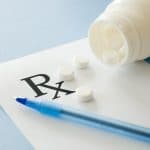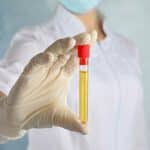What Halcion looks like (including the color and shape) depends on the manufacturer and dosage. The best way to know if the Halcion you’re taking is legitimate and safe is to get a prescription from a healthcare provider.
Halcion is the brand name for triazolam. It’s considered both a benzodiazepine and a central nervous system (CNS) depressant.
It’s typically used in the short-term treatment of sleep problems like insomnia. It works by slowing activity in the CNS, which allows you to sleep longer or lessen how long it takes you to fall asleep.
What Does Halcion Look Like?
Halcion usually comes as a tablet but differs in terms of color, dose, and the imprint on each pill.
White
Halcion comes in a number of white tablets but most of them are 0.125 mg in dosage. They are also mostly elliptical or oval in shape. Where they differ is what they have imprinted on each pill.
The imprint on these pills can include:
- HALCION 0.125
- ING645
- G 3717
- G TR 125
Blue
Halcion can also come as a blue 0.25 mg tablet. These tablets are usually oval in shape and are often scored so they’re easier to split in half if necessary.
Once again, where they differ is the imprint on the front of each pill. Manufacturers put different numbers and letters on their medications.
The imprints on blue Halcion pills can include:
- HALCION 0.25
- G 3718
- 54 620
- ING646
Yellow
Halcion can also be found in a yellow oval tablet. It comes in a 0.25 mg dose and has “G TR 250” imprinted on each pill.
Side Effects Of Halcion Use
Beyond what the pills look like, Halcion also comes with many different side effects. The most common usually range in intensity from mild to moderate, but serious side effects are possible as well.
The most common side effects of Halcion include:
- sleepiness
- dizziness
- lightheadedness
- memory loss
- problems with coordination
- nervousness
- tingling of the skin
- nausea
- vomiting
The serious side effects can include:
- rash
- hives
- itching
- swelling of the eyes, face, lips, tongue, or throat
- trouble breathing
- sleep-driving
- sleepwalking
Halcion Drug Interactions
The use of Halcion with other medications and drugs can lead to adverse effects. The reaction can become so severe that it can be life-threatening.
Some of the drugs that shouldn’t be combined with Halcion include:
- opioid painkillers
- antifungal medications including itraconazole and ketoconazole
- antidepressants
- HIV protease inhibitors including ritonavir and lopinavir
- nefazodone
- nutritional supplements
- certain antibiotics like clarithromycin and erythromycin
- certain calcium channel blockers like diltiazem
- certain histamine-2 receptor blockers like cimetidine
- hormonal contraceptives
- muscle relaxants
- over-the-counter cold or allergy medication
- certain selective serotonin reuptake inhibitors (SSRIs) like fluvoxamine
Grapefruit juice is also not recommended for those taking Halcion. It can increase the effects and the potency of the drug.
Worsening Medical Conditions
Halcion is also contraindicated by a number of medical conditions.
This means the prescription drug can make some medical conditions worse, including:
- depression and suicidal thoughts
- breathing problems
- sleep apnea
- seizures
- kidney disease/hepatic impairment
- liver disease
If you have ever had an allergic reaction to Halcion or other benzodiazepines like diazepam and alprazolam, make sure to let your healthcare professional before they prescribe this medication.
Additionally, if you are pregnant or breastfeeding, let your doctor know. Halcion may harm the fetus or baby.
Overdose Risk
Abusing Halcion increases your risk of an overdose, especially if you mix the drug with alcohol or opioids.
If you see someone experiencing any of the following overdose signs or symptoms, call 911 and get them help as soon as possible:
- amnesia
- respiratory depression
- impaired motor function
- slurred speech
- severe drowsiness/sedation
- seizure
- coma
Halcion Withdrawal
Halcion is classified as a Schedule IV controlled substance by the Food and Drug Administration (FDA). This means it has a lower potential for abuse than other drugs but that it can still lead to dependence and addiction.
If you build up a physical dependence on the drug through abuse, it can become very difficult to stop taking the medication due to potential withdrawal symptoms like rebound insomnia, drug cravings, and depression.
If you or a loved one is struggling with drug abuse and looking for treatment, please contact us today for information on our treatment options.
Sources
Written by
Northeast Addition Editorial Team
©2024 Northeast Addition Center | All Rights Reserved
This page does not provide medical advice.




